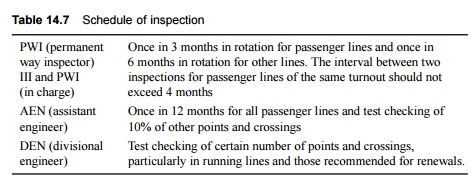Chapter: Civil : Railway Airport Harbour Engineering : Railway Engineering : Points and Crossings
Inspection and Maintenance of Railway Points and Crossings
Inspection and Maintenance of Points and
Crossings
Points and crossings should be
inspected in detail, as the quality of a train ride greatly depends on their
maintenance. The following important points should be checked.
Condition of tongue rails and
stock rails There should be no wear on the top as well
as the gauge face side of the tongue rail. Badly worn out rails should be
replaced. It should be ensured that the turnout side stock rail is provided
with the requisite bend ahead of the toe of the switch; otherwise the alignment
at this spot is bound to be kinky.
Condition of fittings of tongue
and stock rails The fittings should be tight and the
spherical washers must be placed at their correct locations. The slide chairs
should be cleaned and greased with graphite for smooth operation of the points.
The fish plates should be provided with the correct amount of bend at the loose
heel joint. A gauge tie plate should be added if provisions for the same have
not been made.
Gauge and cross level at switch
assembly The gauge and cross levels should be checked for
correctness at the following locations: (i) the stock joint, (ii) 150 mm
(6") behind the toe of the switch, (iii) the mid-switch for the straight
track and for the turnout side, and (iv) the heel of the switch for the
straight track and for the turnout side.
Clearance
between stock and tongue rails at the heel of the switch The correct
divergence to be provided at heel of the switch should be as follows:

Throw of
the switch The throw
of the switch should be as follows

Condition of crossing and tongue
rail The condition of the crossings and of the fittings
should be checked. The maximum vertical wear permitted on a point or wing rail
is 10 mm and these should be reconditioned when the wear is 6 mm. The burn
burrs should also be removed and the fittings should be tightened. The maximum
vertical wear permitted on a tongue rail is 6 mm, whereas the permitted lateral
wear is 8 mm for 90 R and 52-kg rails and 5 mm for 60 R and 75 R rails. The
tongue rail should be replaced or reconditioned before this value is reached.
The Railway Board has recently decided that the maximum vertical wear on wing
rails and the nose of the crossings should be limited to 4 mm on the Rajdhani
and Shatabdi routes and 6 mm on all other routes. The wear limits for CMS
crossings are, however, 5.5 mm for Rajdhani and Shatabdi routes and 7.5 mm for
all other routes.
Gauge and cross level of crossing
assembly The gauge and cross level should be checked at the
following locations and should always be correct: (i) 1 m ahead of the nose on
straight tracks and on turnouts, (ii) 150 mm (6") behind the ANC on
straight tracks and on turnouts, and (iii) 1 m behind the ANC on straight
tracks and on turnouts.
Check
rails The condition of check rails should be ascertained. Check rail
clearances should be as follows:
Maximum Minimum
BG 48 mm 44
mm
MG 44 mm 41
mm
Lead curvature The
curvature should be checked either by the offset method or by the
versine method. The curvature should be correct and uniform.
Cross levels on straight tracks
and turnouts The cross levels on straight tracks and
turnouts should be checked to see that they are correct at all places.
Sleepers The
condition of the sleepers and their fittings should be checked and unserviceable
sleepers should be replaced. The squaring and spacing of sleepers should be
proper and they should be well packed.
Ballast and drainage Enough
quantity of ballast should be available so as to provide an adequate
cushion. The drainage should be proper.
Any other defects If there
are any other defects in the layout, these should be checked and
corrected.
Special
attention is required to ensure that the sleepers are well packed, all fittings
are tightened, gauge and cross levels are properly maintained, and the wear on
the tongue rail as well as on the crossing is within permissible limits. It
should also be ensured that proper distance blocks are provided at correct
locations. The schedule of inspection followed on Indian Railways is given in
Table 14.7.
Table
14.7 Schedule of
inspection

Related Topics